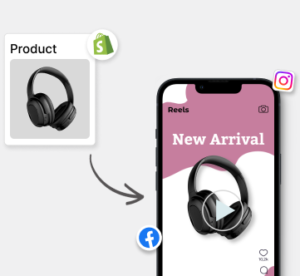Living in a competitive ecommerce landscape, simply running paid ads isn’t enough to stand out. If you’re looking for a cost-effective, performance-driven strategy to grow your online store, affiliate marketing for ecommerce sales might be the solution you’ve been searching for.
Affiliate marketing is a partnership-based marketing model where third-party affiliates promote your products through their channels, like blogs, YouTube, or social media, in exchange for a commission on every sale they refer. It’s a win-win: you get increased traffic and conversions without upfront ad costs, and affiliates earn passive income by driving value.
For ecommerce brands, affiliate marketing is more than just another sales channel, it’s a growth engine. Why? Because it scales with performance, builds trust through authentic recommendations, and taps into niche audiences you might not reach otherwise. Affiliate marketing is responsible for over 16% of global ecommerce sales, putting it on par with email marketing and ahead of social commerce in many industries.
In this guide, we’ll walk you through everything you need to know about using affiliate marketing for ecommerce sales, from how it works and why it matters to setting up your strategy, choosing affiliates, avoiding common mistakes, and scaling your program for long-term success.
Ready to turn traffic into revenue without spending a fortune on ads? Let’s dive in.
What Is Affiliate Marketing and How Does It Work for Ecommerce?
At its core, affiliate marketing is a performance-based strategy where external partners, known as affiliates success kit, promote your products to their audience in exchange for a commission on each successful sale they generate.
The model involves three key players:
- The Merchant (you—the ecommerce business offering the product)
- The Affiliate (a third-party promoter such as an influencer, blogger, or review site)
- The Consumer (the person who discovers your product through the affiliate and makes a purchase)
Here’s how it works: You provide affiliates with custom tracking links or promo codes. They share these through their blogs, social media, emails, or websites. When a consumer clicks on the link and completes a purchase, the affiliate earns a percentage of the sale. It’s a transparent, trackable process that only costs you when results are delivered.
For online stores, affiliate marketing for ecommerce sales is particularly powerful because it’s:
- Scalable – As your affiliate network grows, so does your sales potential, without multiplying your marketing spend.
- Low-Risk and Budget-Friendly – You only pay for actual conversions, not impressions or clicks.
- Performance-Based – Affiliates are motivated to drive sales, which means better marketing efficiency.
Another major advantage is the diverse range of affiliates you can partner with, including:
- Influencers who share product demos and lifestyle content with engaged followers.
- Bloggers and content creators who publish product reviews, comparisons, and how-to guides.
- Coupon and cashback websites that appeal to deal-seeking customers.
- Niche communities and forums with highly targeted audiences aligned with your product category.
Importance Of Affiliate Marketing for Ecommerce Sales?
If you’re an ecommerce brand looking to scale without burning through your ad budget, affiliate marketing for ecommerce sales offers a high-impact, low-risk solution. Unlike traditional marketing methods that require significant upfront investment, affiliate marketing only costs you when a sale is made, making it one of the most cost-effective growth strategies available today.

1. Cost-Effective Compared to Traditional Advertising
Paid social ads, Google Ads, and influencer sponsorships often come with high upfront costs and unpredictable returns. With affiliate marketing, you only pay for performance. Affiliates are incentivized to drive actual sales, not just clicks or views. This makes it ideal for ecommerce businesses working with tight marketing budgets or looking for better ROI.
2. Reach New Audiences and Untapped Niches
Affiliate marketing allows you to tap into existing, highly engaged communities that you may not otherwise reach. Whether it’s a beauty influencer on YouTube, a niche blog in your product category, or a deal-focused website, your brand gets in front of relevant audiences who are already primed to buy.
3. Boost SEO Through Quality Backlinks
When reputable affiliates link back to your ecommerce posts, it doesn’t just drive traffic—it improves your search engine visibility. Quality backlinks from blogs, product reviews, and niche websites can help boost your domain authority and organic rankings over time.
4. Build Trust Through Third-Party Endorsement
Today’s consumers are skeptical of brand-generated ads but trust recommendations from real people. Affiliates—whether they’re influencers, bloggers, or content creators—lend credibility to your products. Their endorsements act as social proof, increasing the likelihood of conversions.
5. Real Brands Are Winning with Affiliate Marketing
Many ecommerce giants use affiliate marketing to drive significant revenue. For example:
- Amazon Associates helped Amazon scale its product reach in virtually every niche.
- Sephora’s affiliate program empowers beauty bloggers to create tutorials and drive product sales through affiliate links.
- Smaller DTC brands like Glossier and Gymshark have grown loyal customer bases by partnering with micro-influencers and content creators.
Setting Up an Affiliate Marketing Strategy for Ecommerce Sales
Launching a successful affiliate marketing strategy for ecommerce sales requires more than simply signing up affiliates and handing out links. To drive real revenue, you need a clear plan, the right tools, and a well-vetted network. Here’s a step-by-step breakdown to help you set up an affiliate program that performs.
Step 1 – Define Your Goals and KPIs
Before you invite affiliates to promote your store, it’s essential to define what success looks like. Do you want to:
- Increase traffic to your online store?
- Improve your conversion rate?
- Promote new product launches or clear excess inventory?
Once your goals are set, identify measurable KPIs to track performance. Common metrics in affiliate marketing for ecommerce sales include:
- Conversion Rate – How many clicks lead to purchases?
- Average Order Value (AOV) – Are affiliates bringing in high-value customers?
- Return on Investment (ROI) – Are your affiliate commissions yielding profitable returns?
Step 2 – Choose the Right Affiliate Platform or Software
Your choice of platform plays a key role in managing and scaling your affiliate program. If you’re using WordPress, then a WooCommerce affiliate plugin can make it easy to set-up and manage your entire program directly in your store dashboard – no need for a third-party platform.Here are some top-rated options:
1. ShareASale – Great for small-to-medium ecommerce brands; user-friendly and affordable.

2. Refersion – Tailored for Shopify users and integrates easily with ecommerce platforms.

3. Impact – Ideal for scaling and managing global affiliate partnerships with advanced analytics.

4. Awin – Large global network with access to premium publishers.

You can also decide between:
- Self-hosted programs (managed directly through your ecommerce platform using apps or custom integrations).
- Third-party networks that provide affiliate recruitment, tracking, and reporting tools.
Step 3 – Recruit and Vet the Right Affiliates
Not every affiliate will be the right fit. Choose quality over quantity by focusing on:
- Relevance – Does the affiliate’s content align with your brand and products?
- Engagement – Are they actively connecting with their audience through comments, shares, or DMs?
- Authority – Do they influence your niche or industry?
- Performance History – Have they delivered results for other brands?
Pro tips for affiliate recruitment:
- Browse affiliate networks and marketplaces.
- Use social listening tools to discover potential partners talking about your niche.
- Reach out directly to content creators, bloggers, or customers who already love your products.
Step 4 – Create High-Converting Affiliate Creatives
Don’t expect affiliates to design everything themselves. Provide them with a toolkit of professionally branded assets such as:
- High-quality banners and product images
- Pre-written email templates and Affiliate Marketing for social media captions
- Custom coupon codes for easy tracking and exclusive incentives
Step 5 – Set Up Commission Structures and Tracking
Incentivizing your affiliates fairly is key to long-term success. Common structures include:
- Percentage-based commissions (e.g., 10% per sale)
- Flat fees for specific actions (e.g., $5 per lead or $20 per sale)
To track results accurately, use affiliate software or platform analytics that provide:
- Real-time reporting of clicks, conversions, and payouts
- Attribution tools to ensure the right affiliate gets credit for the sale
How to Measure the Success of Affiliate Marketing for Ecommerce Sales
Once your program is up and running, the real work begins: tracking, analyzing, and refining your strategy to maximize results. Measuring the success of affiliate marketing for ecommerce sales is crucial to understand what’s working, identify underperforming areas, and scale profitably.
1. Use Analytics Tools and Affiliate Dashboards
To accurately measure affiliate performance, leverage both third-party analytics tools and the built-in dashboards of your affiliate platform. Key tools include:

Google Analytics (GA4) – Use UTM parameters to track traffic, conversions, bounce rates, and user behavior from affiliate links
2. Understand Attribution Models for Affiliate Traffic
Attribution is the process of crediting a sale to the correct marketing channel. In affiliate marketing for ecommerce sales, this can get tricky, especially if multiple touchpoints were involved in the customer journey.
Most affiliate programs operate on a last-click attribution model, where the affiliate who generates the final click before purchase gets the commission. However, some brands use multi-touch or first-click models depending on the affiliate’s role in the funnel.
Understanding your attribution model helps:
- Prevent double-counting of conversions
- Fairly compensate affiliates
- Optimize your funnel by knowing who drives awareness vs conversions
3. Conduct Regular Affiliate Program Audits
A monthly or quarterly audit ensures your program stays aligned with business goals. Your audit checklist might include:
- Reviewing top-performing affiliates and their traffic sources
- Evaluating underperforming creatives or campaigns
- Checking for broken links or outdated promo codes
- Monitoring affiliate fraud or suspicious activity
- Analyzing customer lifetime value (LTV) from affiliate-acquired customers
4. Optimize Based on Performance Data
To improve your affiliate marketing for ecommerce sales, act on what the numbers are telling you. Some optimization tactics include:
- A/B testing different creative assets (banners, headlines, CTAs)
- Rotating commission tiers to incentivize affiliates who consistently convert
- Improving landing pages for a better user experience and mobile responsiveness
- Removing low-performing affiliates and focusing on high-converting ones
Boost Sales on Social Media with AI ⚡️
TRY NOWPredis.ai in E-commerce Marketing
Creating visually striking, conversion-ready content can be time-consuming, especially for ecommerce businesses managing multiple SKUs or running frequent promotions. That’s where Predis.ai steps in. It uses AI to simplify the process of content creation, helping brands produce engaging social media posts that align with their goals and brand identity.

Predis.ai transforms content creation from a tedious task into a strategic advantage, perfect for busy ecommerce teams looking to maintain consistency and creativity without hiring a full-scale content team.


















